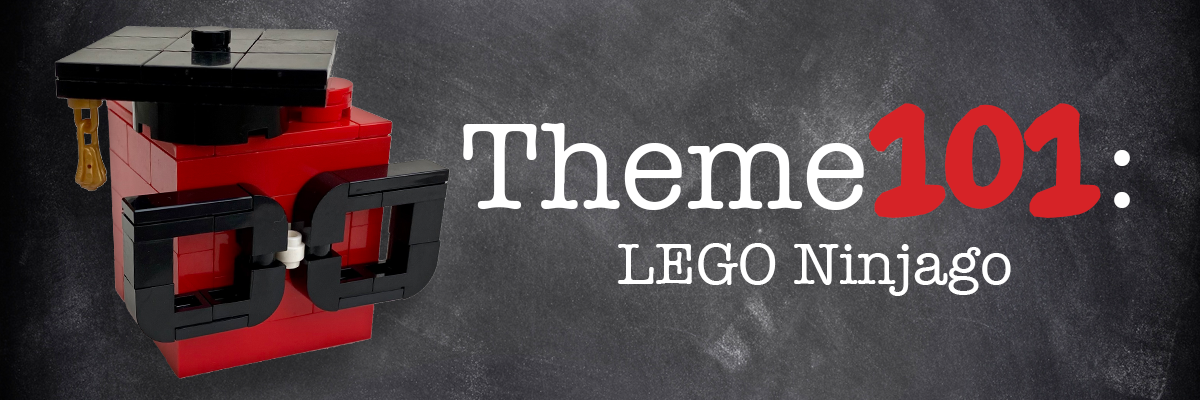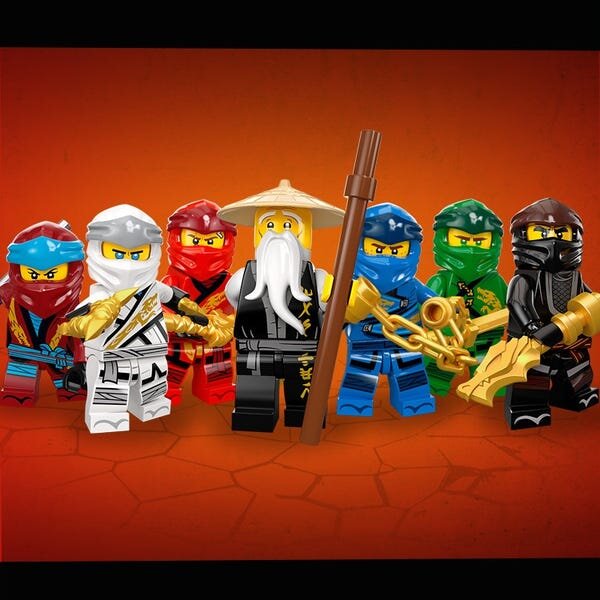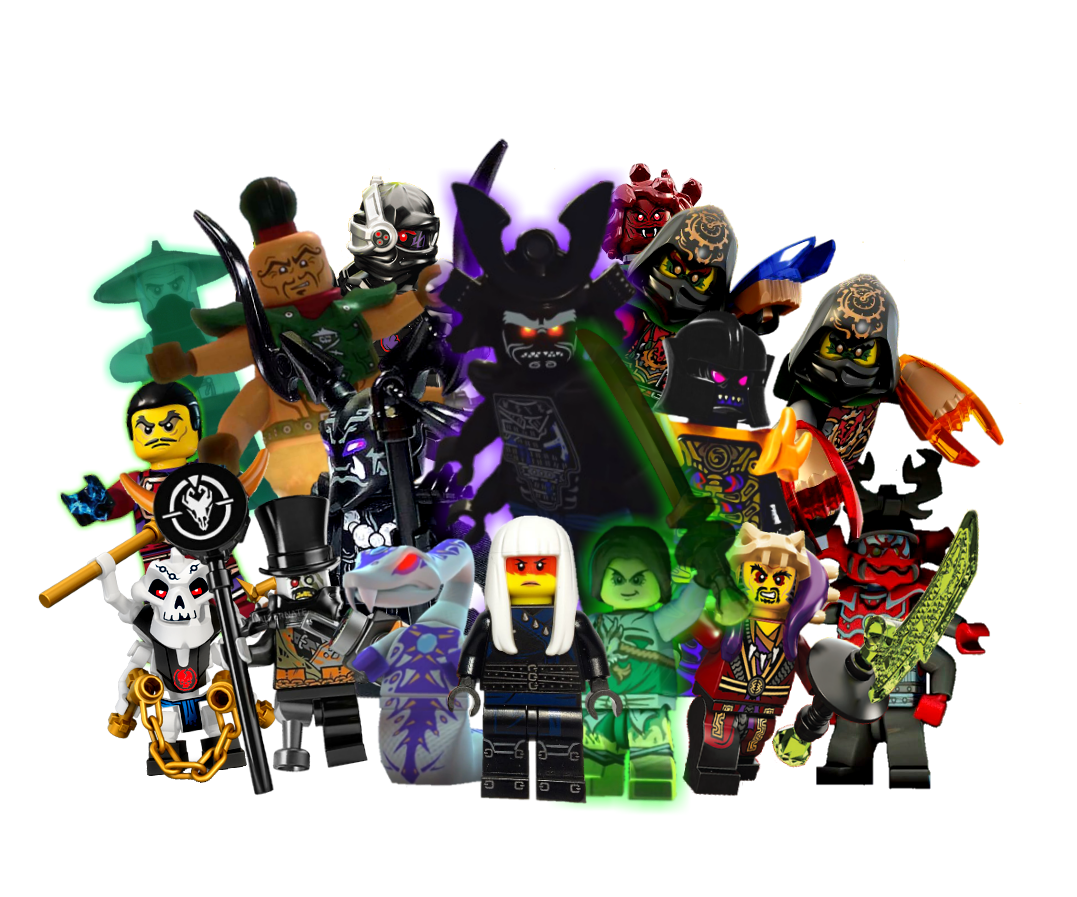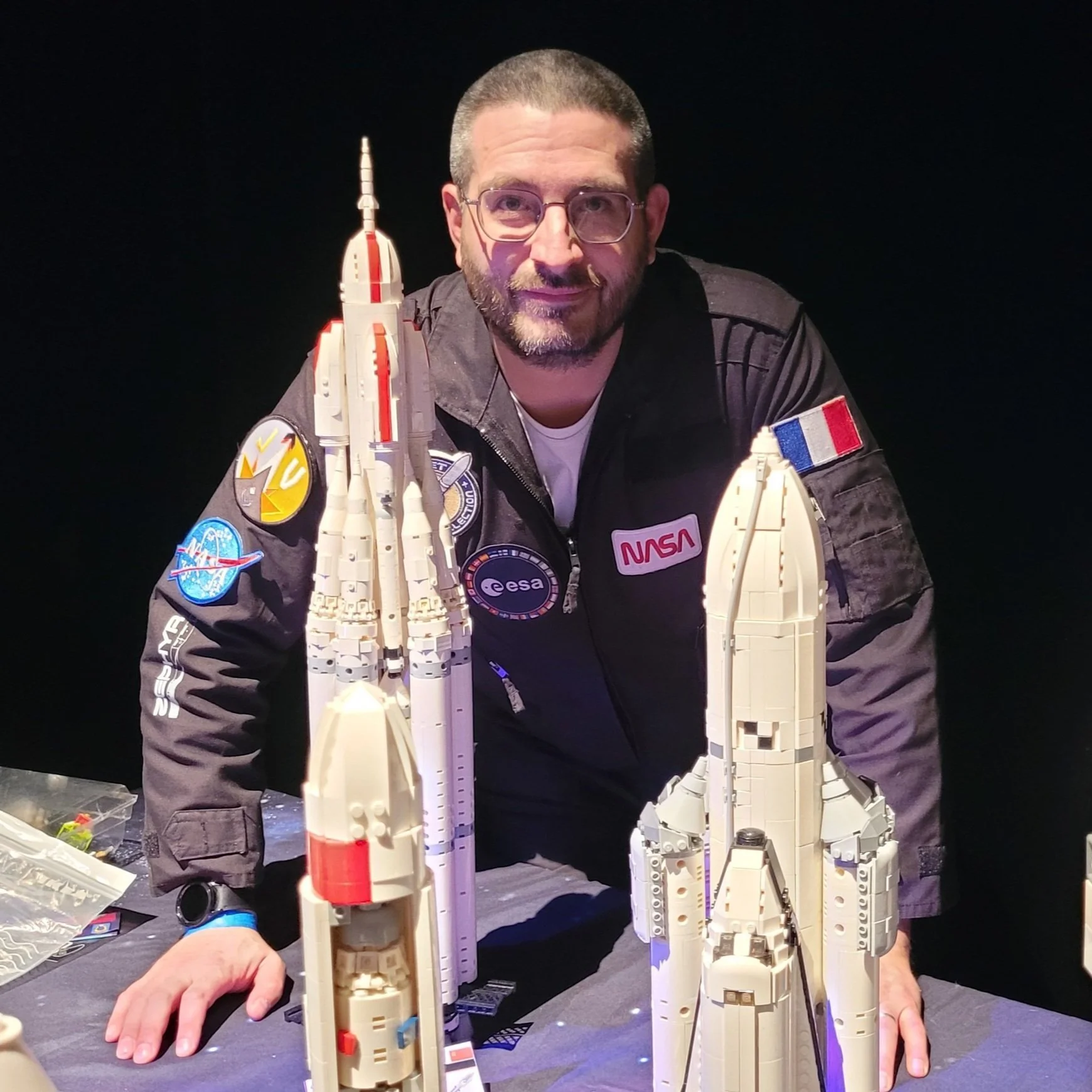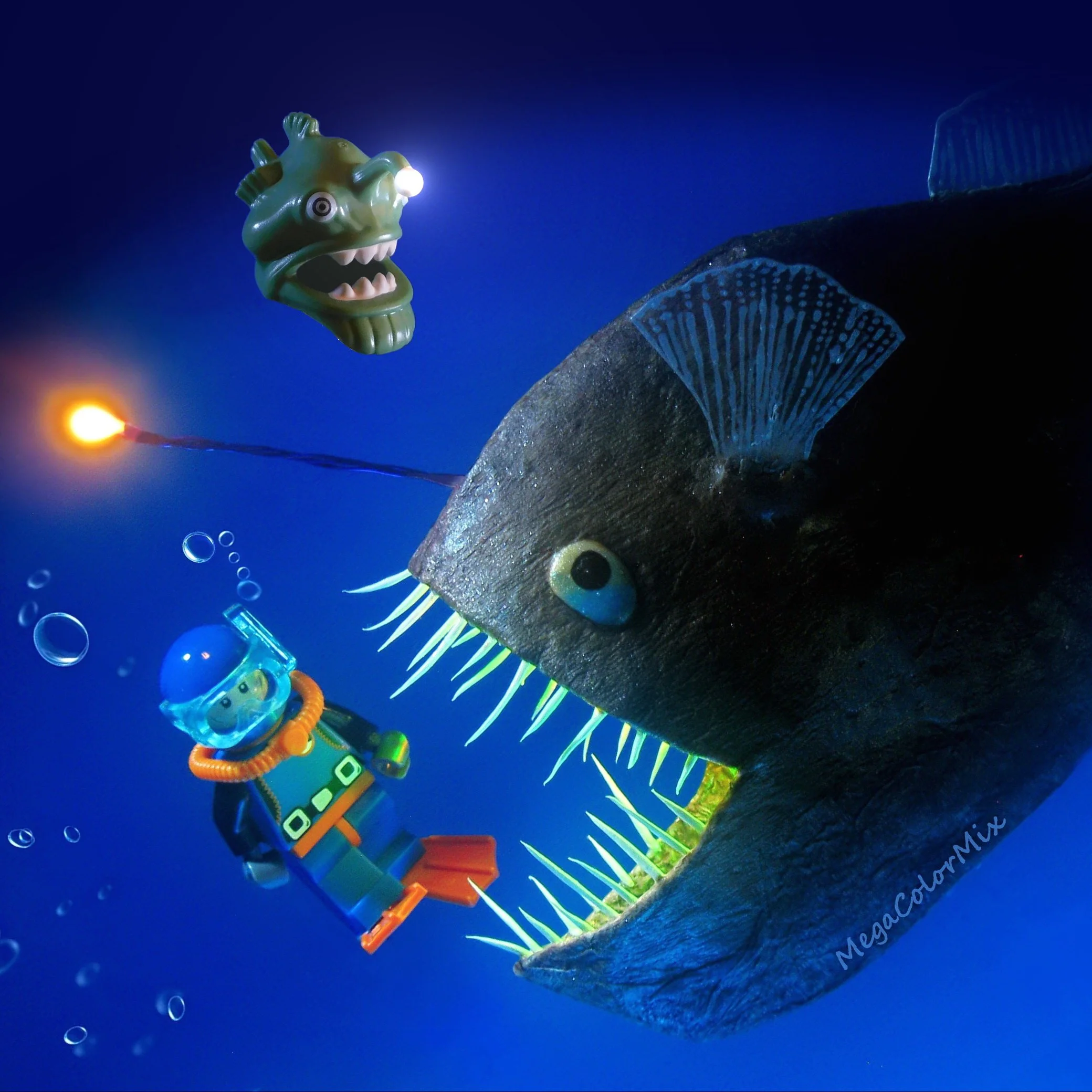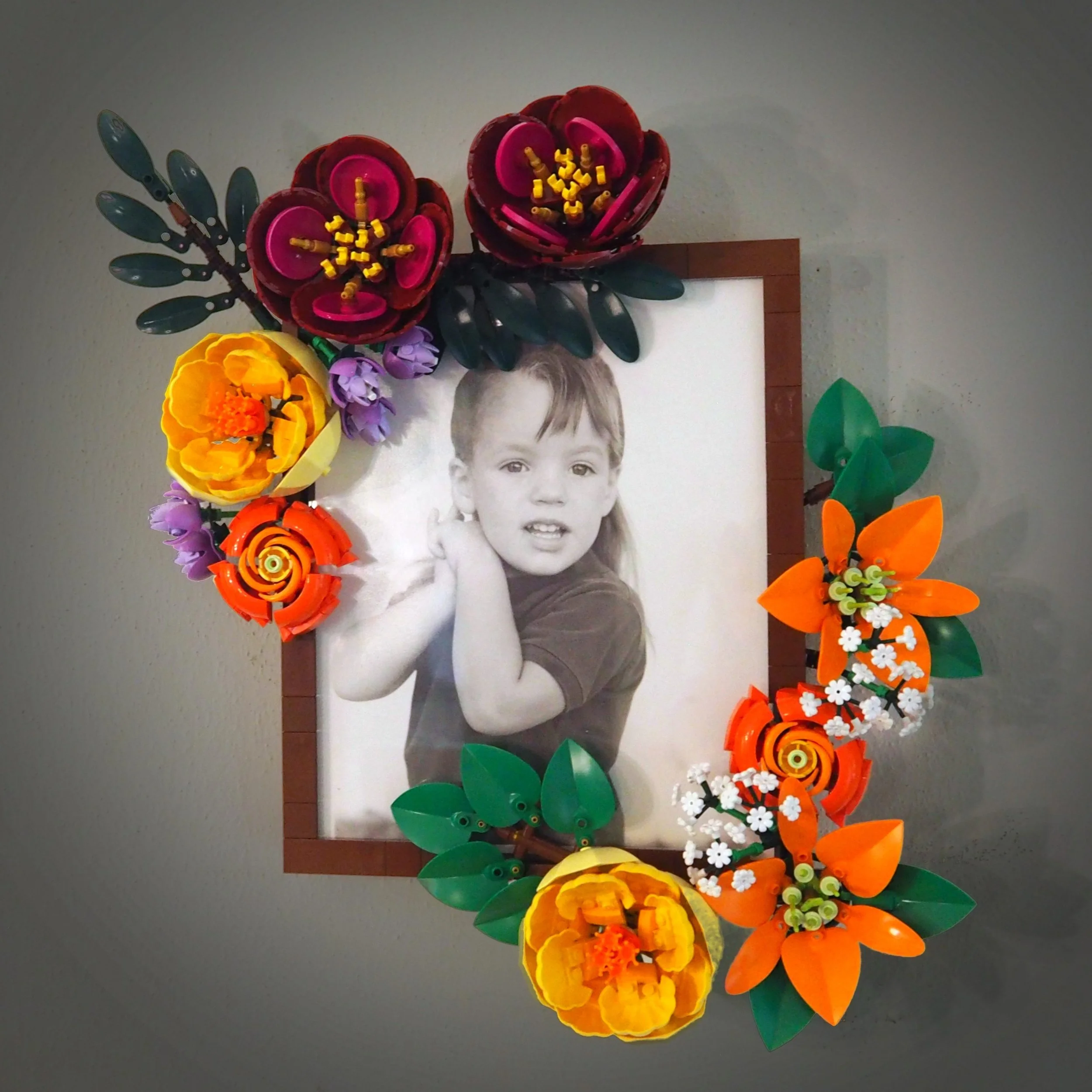Theme 101: LEGO Ninjago
/Can you believe that we’ve enjoyed ten years of LEGO Ninjago! Have you been wondering what all the hype is about this month? In the first of our Theme 101 series, we’ll take an in-depth look into the world of LEGO Ninjago. We’ll explore the history, Easter eggs, highlights, and share some of the best communities around to dive deeper into the vast world of the ninjas!
History of the Ninjago Theme
LEGO Ninjago quickly became one of LEGO’s cornerstone themes since its conception more than 10 years ago. While many of the attempts by LEGO for a modern, story-driven theme have been short-lived, Ninjago has continually found ways to expand its presence through a variety of evolutions, spin-offs, and branching into other forms of media. From the first year’s massive wave of sets to becoming one of the most profitable and prolific themes produced, LEGO Ninjago has built quite the legacy—and looks to continue for years to come.
The first aspect to realize about Ninjago is that it was not intended to have such a sustained lifespan. LEGO typically produces what are known as “Big Bang” themes: a LEGO-owned IP that has high production values and high concepts that explodes into the market initially before concluding on a schedule a year or two later. Ninjago had a solid story, a TV show, and about three years to run its course. If you ever wondered why the sets that came out in correlation with Season 2 were called The Final Battle, well… that was actually supposed to be the final battle.
If you think back to the early years of Ninjago, obviously you’ll remember the vast amounts of marketing and products being pushed. But you’ll also remember just how well it stuck with kids and many AFOLs alike. If the general public could tell it was immensely popular, you bet the people calling the shots at LEGO noticed that too. This is why Ninjago is now what is called an “Evergreen” theme—basically meaning it’s going to keep going until something drastically changes. Maybe you’ve heard of some of the other themes that are regarded in this way: City, Star Wars, Friends, essentially everything that lasts for longer than that three-year mark.
Via Wikipedia
With Ninjago as an evergreen theme, there are now almost 400 sets, the show is entering the 14th season (not counting various spin-offs and specials), it inspired a feature film in The LEGO Movie universe, entire lands have been built inside a number of different LEGOLAND parks, and the theme has won a Toy of the Year. Not too shabby.
Ninjago on TV
To best understand the run of Ninjago, it’s easiest to compare the sets to the TV show seasons. Each new season has ushered in at least one new wave of sets. In short, it looks like this:
Pilot Episodes (sets released under The Golden Weapons)
Timeline via LEGO
Rise of the Snakes
Legacy of the Green Ninja (sets released under The Final Battle)
Rebooted
Tournament of the Elements
Possession
Skybound
6.5. TV Special: Day of the DepartedThe Hands of Time
Sons of Garmadon
Hunted
March of the Oni
Secrets of the Forbidden Spinjitzu
Prime Empire
Master of the Mountain
The Island (upcoming season)
In addition to sets that correlate with TV seasons, several set releases have fallen under either the new Legacy title (essentially updated remakes of various prior sets, especially from the Pilot) or Spinjitzu sub-theme (=focused on the Spinjitzu play features).
Part of what makes the Ninjago theme so appealing is that many of the seasons and sets have a very distinct flair. Over the course of a decade, you need innovation to keep the story and the sets interesting. Fan of snake people? Well, Rise of the Snakes sets may be for you. More into spooky skeletons? Try out the pilot episodes. Video games? Prime Empire draws from classic 8-bit to modern action games. Want something crazy different like steampunk pirates? Well, you’re still covered with Skybound. There really is something for just about everyone, from collectors to MOC builders. And there’s still more on the way.
Look at all that variety! Image via: CrossoverKing16 on Deviantart
For many of us AFOLs, it is important to realize just how powerful the tie-in with the television show is for kids. LEGO Ninjago originated with the corresponding Ninjago: Masters of Spinjitzu TV show, premiering on January 14th, 2011 on Nickelodeon in Denmark, Teletoon in Canada, and Cartoon Network in the United States. Since the beginning, the show and the sets have gone hand in hand. The connection to television and all other media creates an even more appealing world for everyone to engage in—not to mention a prime marketing environment for LEGO.
Ninjago LEGO Sets
Because of its longevity, Ninjago has inspired hundreds of products in different forms. This is a visual summary of all the places Ninjago has appeared across the LEGO portfolio from their own theme to making appearances in others. Sets can be broken down into the following categories:
Ninjago: Almost 400 sets and growing (includes LEGO Magazine kits).
2507: Fire Temple from 2011. Image Via Brickset
71722: Skull Sorcerer’s Dungeon from 2019. Image via Bricklink
Ninjago Magazine: 87+ sets (each issue has a foil pack containing a small set or minifigure).
The original Foil Pack gift from the Ninjago Magazine, featuring Kai. Image via Bricklink
The LEGO Ninjago Movie: 28 sets.
The first wave of The LEGO Ninjago Movie sets. Image via ibrickcity.com
The LEGO Ninjago Movie Collectable Minifigure Series: 20 figures.
Display box of The LEGO Ninjago Movie Collectable Minifigure series. 20 to collect in standard Collectable Minifigure Series style. Image via Bricklink
LEGO Dimensions: Six unique Ninjago packs.
All avaliable LEGO Dimension packs featuring Ninjago characters. Utilizing the characters allowed access to the Ninjago world within the game. Image via Amazon
The LEGO Movie: One set, 70815: Super Secret Police Dropship.
The Green Ninja’s appearance in 70815: Super Secret Police Dropship. Image via Bricklink
Juniors: Three sets from the standard Ninjago theme, one from The LEGO Ninjago Movie.
10722: Snake Showdown, one of the LEGO Ninjago sets from the Juniors line featuring easier to build sets and larger pieces. Image via Amazon
LEGOLAND: One set based on the Ninjago World and ride at LEGOLAND parks.
Overall, Ninjago’s continued success has largely been due to the variety of topics the theme has covered. There is basically something for everyone within the copious sub-themes. Variations of horror, steampunk, fantasy, video games, classical ninjas, architecture, and mechs are just a few of the major concepts that appeal outside of the already-deeply-rich lore of the Ninjago theme itself.
The theme is also one that appeals to a wide variety of age groups for so many reasons—with sets with low price points like polybags and Collectable Minifigures all the way up to the high prices of the advanced builds of the Ninjago City line. A strong focus on play features in the form of Spinjitzu spinners and Airjitzu flyers coupled with battle arenas and a host of play features packed into each set combined with the television show are some of the highest contributing factors towards the success.
Characters and Minifigures
Given the sheer scope of the theme, you’d expect there to be a few characters. Well, Bricklink currently lists almost 700 unique minifigures throughout the different sub-themes of Ninjago! Obviously, there are many variations of specific characters, but overall there are just too many to get into all of them here (I would strongly recommend the Ninjago Wiki for any character-related questions).
However, since Ninjago is largely recognizable from the core ninjas, here’s a quick rundown of some of the most important characters from the series and how to recognize them. (All images via LEGO.)
Cole
The Elemental Master of Earth. Almost always seen wearing black clothing, occasionally with gray and orange highlights. Known for his strength, especially in combination with his mastery of the earth elements.
Jay
The Elemental Master of Lightning. His primary color is blue. He is considered the humorous and lighthearted one of the group. Has a mastery of lightning and electricity.
Kai
The Elemental Master of Fire. Almost exclusively wears red, occasionally with heavy black highlights. He is often portrayed with a bandage and a scar on his face, though in some instances these are absent. His personality is often fiery, which goes along with his mastery of fire.
Lloyd
The Elemental Master of Energy and the current leader of the ninjas. Recognizable by his blonde hair and use of green or gold clothing. His personality has become wise and mature, growing from an unruly child as the son of Lord Garmadon. Lloyd possesses the most total power of all the ninjas.
Nya
The Elemental Master of Water and Kai’s sister. Nya has many different appearances, initially characterized by a bob haircut, but now as a somewhat messy ponytail. Often seen in her Samurai X persona, she wears largely red with heavy armor at times. Other outfits feature heavy amounts of dark red, black, and dark azure. Though now training as a ninja, she is very independent and very capable.
Zane
The Elemental Master of Ice. Easily identified at times with his Nindroid (android) appearance, he is largely seen wearing white clothing, but has a much more diverse range than most, appearing in pink, light blue, and many times with silver and black highlights. Unsurprisingly, Zane is often robotic in nature. Has control over ice, but as a Nindroid, possesses significant strength and intellect.
Master Wu
Master of Creation and mentor to the ninjas. The second son of the First Spinjitzu Master and younger brother to Garmadon. He is easily recognizable with his long white beard in his white robes and a traditional straw hat. Much of his wisdom comes from his family ties and his age, which is over a thousand years old.
Lord Garmadon
Lord of Destruction and older brother of Wu. He was raised learning the ways of the ninjas, but was infected with evil when bitten by the Great Devourer. With many different appearances, his most iconic is that of dark skin with glowing red eyes, white facial markings, and four arms. He is almost always wearing some sort of heavy armor. He is the father of Lloyd.
As stated, this just barely scratches the surface of the characters in both the sets and the show. One of the reasons that collecting Ninjago minifigures is so popular is due to the fact that many of the characters are given important roles and rich backstories, even if they’re not a major character. )Oh yeah, and a bunch of the figures are really cool!)
Many AFOLs find more interest in just the minifigure pieces than the entire fig, as many Ninjago specific parts and prints are heavily used in the creation of FigBarf (essentially the mass building of “original” characters from other minifigure parts, Read more about that trend here from A. Lemur).
Figbarf: Each figure utilizes at least one Ninjago part to create unique new characters
Most of the recent Kendo, Ninja, and Samurai minifigure pieces have originated out of the Ninjago theme, while other parts such as ghost elements, humanoid snakes, skeleton variations, cyber and steam-punk prints and molds, and sea creature elements from The LEGO Ninjago Movie’s Shark Army highlight some of the more unique contributions. Whether you’re into Ninjago minifigures for the characters or just the parts, there are tons of amazing figure pieces we probably would not have gotten without Ninjago.
The Ninjago Fan Community
While Ninjago is definitely a theme that largely appeals to children, there are still a number of communities online that host vivid TFOL and AFOL discussions around the theme and additional media. Here are some of the most prominent places where LEGO fans gather to talk all things Ninjago. Feel free to comment below with any additional communities we may have missed.
Eurobricks Forums: The current 2021 Ninjago thread has over 118,000 views and 1,600 comments. And that’s just one of many threads on the theme. Eurobricks is one of the most active online communities for discussion LEGO in general, but Ninjago-specific branches are quite popular.
Ninjago Wiki: A bit less on the community interaction side, but a valuable resource with a fair amount of discussion. The social posts lean more towards a younger audience, but the wiki hosts a very comprehensive look at the lore and history of Ninjago.
The Brick Blogger: While far from the heyday of 100+ comment chains, LEGO Ninjago articles still receive a fair amount of attention. Digging back into earlier articles reveals a treasure trove of information, especially focused on the show.
Reddit r/Ninjago: A fairly fast-moving community (posts are still viewable but you are unable to comment after a few months) with up to 50 posts a day. There’s a heavy focus on memes, collecting, and art, and the platform definitely caters towards more of the TFOL crowd but is a very welcoming community that encourages submissions and engagement.
Steam: The LEGO Ninjago Movie Video Game community is a hub for all things related to the video game based on the movie. It contains helpful guides for the game as well as general discussion.
Fan Conventions: Ninjago City 70620 really started shaping Ninjago as a centerpiece theme for LEGO fan conventions worldwide. The Ninjago City building standard has inspired collaborative builds of sprawling cityscapes, all based on the style of that original set. The Brothers Brick laid out a definitive guide for BrickCon 2018, found here, that has been utilized as a guide for numerous MOCs. BrickCon and BrickCan have both displayed huge collaborations of this style. However, the best way to encourage the Ninjago theme at fan conventions is to either reach out to a coordinator or even just start showcasing MOCs.
Via BrickCan
Ninjago in Other Forms
Film
LEGO Ninjago made a brief big-screen debut in the original LEGO Movie with Lloyd appearing as one of the “Master Builders.” This would obviously not be the last appearance of Ninjago on the big screen, as one of the spinoff films would later be The LEGO Ninjago Movie which debuted in 2017. While various specials have occurred throughout the show’s lifespan, the motion picture allowed a different cast of blockbuster voicess to take on the roles of the familiar characters. However, even with the sustained success of the franchise, the film was the most disappointing of the LEGO Movie universe in terms of box office and critical performance.
Video Games
LEGO Ninjago has appeared in a wide variety of video game titles so far. Within a few months of the original release of the TV series and the first wave of sets, the first Ninjago video game hit the markets: LEGO Battles: Ninjago for Nintendo DS. Following up in 2014 LEGO Ninjago: Nindroids added a second title to the Masters of Spinjitzu video game series.
Other notable games include LEGO Ninjago: Shadow of Ronin (2015) and The LEGO Ninjago Movie Video Game (2017). However, Ninjago has appeared in a variety of combined-theme games as well, most noticeably as playable characters and an entire dedicated Ninjago world in the toys-to-life game LEGO Dimensions (2015) and briefly in LEGO Universe (2010). On top of these high-profile games, a significant number of LEGO.com-hosted web games and multiple app-based mobile games have also featured LEGO Ninjago.
LEGOLAND Parks
While not targeted exclusively to the traditional AFOL community, LEGOLAND parks all over the world have dedicated an entire land to the theme with various rides and experiences. The flagship experience is LEGO Ninjago The Ride, an interactive 4-D ride that puts you into training with the ninjas. Currently, LEGOLAND Florida, California, Billund, Deutschland, Japan, Malaysia, Windsor and New York (when the park opens) all feature the full Ninjago World. Dubai is currently the only park without the land, but plans are still unknown for Korea, Shanghai, and the potential park in Belgium.
The inclusion of Ninjago World in the parks has allowed for an (attempted) increase in diversity of food and culture in addition to the standard theme park fare, as the Ninja Kitchen food carts feature Bao and Bahn Mi. Given the theme, the retail shops in Ninjago World carry almost exclusively Ninjago products, which (in my experience) has included access to extremely knowledgeable staff on all things Ninjago.
At LEGOLAND California, in addition to the world, the short film LEGO Ninjago: Masters of the 4th Dimension debuted in 2018 making use of the park’s 4-D capable theater. This short experience would later travel to many of the other parks and Discovery Centers due to popularity. Again, while the theme park attractions may not be the biggest draw for AFOLs, it’s a great way to let kids experience the world of Ninjago interactively and in person—and it may end up turning more AFOLs into Ninjago fans.
Publications
There are numerous published works of both fiction and resource varieties available in regards to the Ninjago World, with Bricklink listing over 200 unique and variant books. These publications include visual dictionaries and character encyclopedias (often with exclusive minifigures), trading card holders, “Build Your Own Adventures” (with included LEGO bricks), sticker books, and graphic novels. There are also over 200 variations of the LEGO Ninjago Magazine in a wide variety of languages. One of the most appealing aspects of the magazines is the inclusion of a mini model or minifigure with purchase, a tactic prevalent among the LEGO-themed magazines across Europe.
Ninjago Easter Eggs
LEGO set and graphic designers are known to include references to past themes in their sets as well as hidden Easter eggs for eagle-eyed fans. Here are a few “cross-over events” that we’ve noticed over the years.
LEGO NINJA
In many ways, Ninjago was a successor to the original Ninja line (1998-2000). Ninjago features parts that directly originated in the line (i.e. Part 30177: Minifigure, Headgear Ninja Wrap) and updated others (i.e. the Katana). More noticeable is the inclusion of an almost identical “Glider” (set 1187) in 70751: Ninjago Temple of Airjitzu.
Other LEGO Theme Iconography
Significant amounts of iconography exist in the Ninjago world that appears elsewhere in the LEGO universe. Here is a list of some noticeable examples:
70751
Temple of Airjitzu
Features the Postman sporting the traditional LEGO Post Office logo found throughout Classic Town, modern City, and Train themes. While this logo is derived from the historical “Post Horn,” LEGO has kept a distinct variation from 1982 till today—of which the Postman’s outfit clearly reflects. Additionally, LEGO has utilized the official Royal Mail logo on occasion, and a few different variations of the horn logo have appeared as early as 1967 throughout a number of early train sets. There is also a distinct variation of the horn icon for the Winter Village line with a chord wrapped around the horn.
Image via: Brickset
Set 6363: Post Office, released 1982 in what is now considered Classic Town. One of the original appearances of the LEGO Post Horn logo.
Image via: Brickset
Image via: Bricklink
70591
Kryptarium Prison Breakout
The Prison Guard and prisoner outfits designs in this set originated in the LEGO City Police line. In fact, the Prison Guard’s torso is the same one featured in 35 different sets and over 30 unique Minifigures! This would be the final time the uniform would be utilized, coming at the end of 12 years of service. While updates to the police-style have been gradually made, it is likely due to a need to rebrand, seeing the number of criminals still on the streets of LEGO City!
Image via: BrickLlink
70620
Ninjago City
Taking place in The LEGO Ninjago Movie world, Ninjago City is absolutely loaded with references and tie-ins to a vast amount of other LEGO themes and properties. Logos such as the classic 1990’s M-Tron and 2002’s Island Xtreme Stunts are hidden throughout the city. A Chima Lion, Fabuland’s William Walrus, Unikitty, and even Johnny Thunder appear on some of the trading cards. One of the most entertaining inclusions is that of Galidor: Defenders of the Outer Dimension, LEGO’s now-notorious 2002 theme (which was another theme with a television tie-in) in both the form of Mother Doomsday’s shirt and the movie poster.
Image via: Brickset
Via Lego
70657
Ninjago City Docks
Another set from The LEGO Ninjago Movie, once again loaded with hidden references. Highlights include references to 2000’s Adventurers Set 5935: Island Hopper and 2014’s Ultra Agents set 70162: Inferno Interception. Both generations of Bionicles are represented the first with a map of Mata Nui, and the second with an image of The Mask of Ultimate Power. A personal favorite is the inclusion of a Junkbot arcade game cabinet, a reference to a classic LEGO.com Flash game.
Image via: Brickset
Via Eurobricks review for Ninjago City Docks
The original Junkbot start screen. A robot works in a factory. The player moves the bricks to solve puzzles and help Junkbot get to the recycling cans. Image via Brickipedia
While still part of Ninjago City, this is the first of the set to fall outside of The LEGO Ninjago Movie line. Even without The LEGO Movie world’s direct tie-ins to other themes, the set is still loaded with a variety of iconography in reference to other classic LEGO themes, as well as references to deeper Ninjago lore. Some of the highlights include throwbacks to Ice Planet 2002, Rock Raiders, Model Team, and Space Police III. There are even more subtle references to stranger themes like Clikits and Znap!
Image via: LEGO
Chima
Ninjago and Chima may be more closely tied together than you think. According to Ninjago showrunner Tommy Andreasen’s Twitter (check him out for tons of great facts about Ninjago and his other projects), there was an idea that the snakes in Ninjago may have come from the land of Chima. At the very least, the Chima line did not get snakes because they were already prominently featured in the Ninjago line.
Kill Bill
Ninjago and Kill Bill!? Well, you can be the judge on this one. Upon the release of 71708 Gamer’s Market, many people started drawing the comparison between Avatar Harumi’s outfit and that of The Bride from Kill Bill. Will LEGO admit this? Probably not given the film’s... somewhat violent nature, but there’s clearly some inspiration here.
Via Hero.fandom.com
Via Bricklink
Other LEGO Elements
Curious about how Ninjago has influenced other sets and themes? Want to see some of the lasting impact and new parts that the theme has introduced? Check out the fantastic summary from our friends at New Elementary for their great write-up “10 Years of new LEGO Ninjago Pieces.”
Conclusion
While this Theme 101 article hopefully fulfills your curiosity about everything Ninjago, we know there is no way to fully explore the entire depth of a 10-year-strong theme in a reasonable amount of space. (Though 4,000 words is a decent attempt, I think!) Feel free to add-on in the comments about anything that relates to the world of Ninjago that we missed. And until next time, “Ninja, Go!”
Is there anything that didn’t get featured you really want the world to know about Ninjago? Leave your thoughts in the comments below.
Do you want to help BrickNerd continue publishing quality articles like this one? Become a patron to show your support, get early access, exclusive swag and more.

